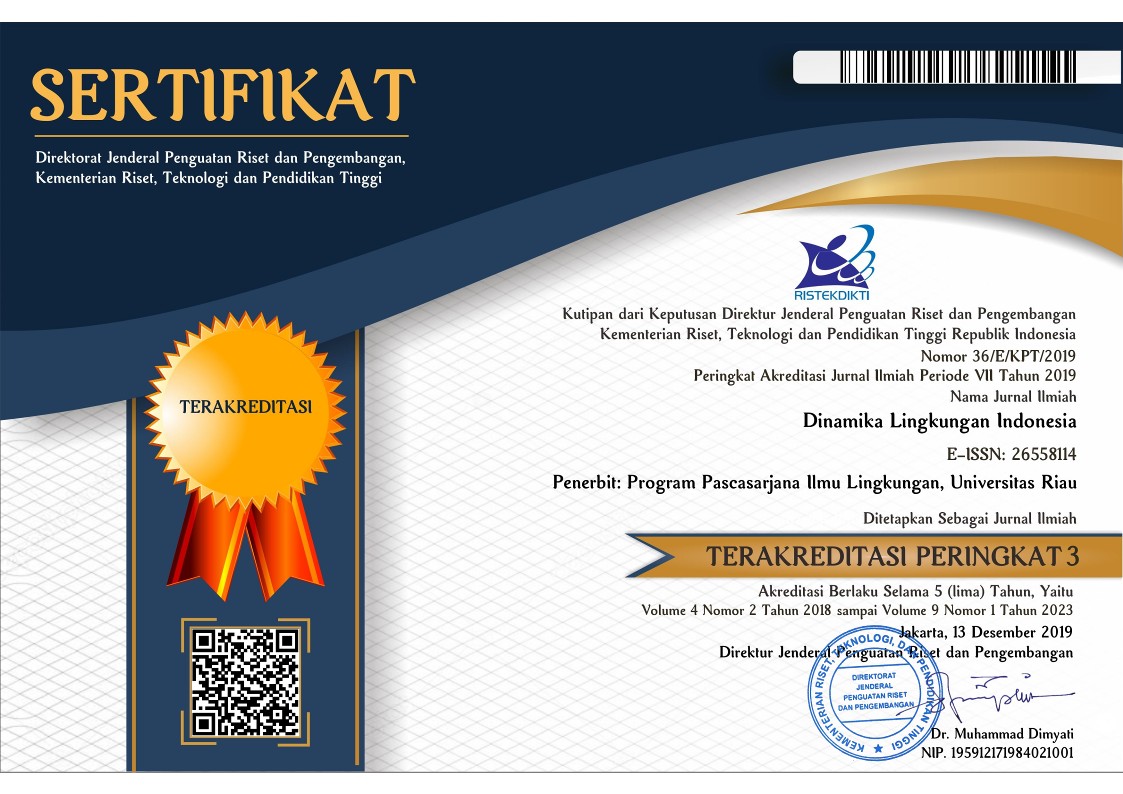Konsumsi Air Kajian Kelayakan Sumur Perumahan Tipe 36 di Kota Pekanbaru
Abstract
The purpose of this study is to analyze well water consumption properness, to analyze the effect of length septic tank to well water properness, and to analyzethe effect of soil type to well water consumption properness of type 36 housing in Pekanbaru. The method of this study is quantitative with cross sectional. Based on the analysis result, it is found that the feasibility of the well water consumption in the type 36 housing in Pekanbaru City on the turbidity parameter is only Rumbai Sub-district exceeding the quality standard, Escherichia coli parameter or total coliform exceeds the standard quality, pH parameter has acid water does not reach the quality standard. The influence of the distance of the fecal container tube with the feasibility of the well water of type 36 housing in Pekanbaru City is the parameter of Escherichia coli or total coliform by using chi-square test has correlation or interplay relationship ≤ 0.05. The influence of soil type that is found on the feasibility of well water of type 36 housing in Pekanbaru City is on Escherichia coli parameter by using chi-square test has correlation or interrelation relationship ≤ 0.05. The results of the analysis of the water wellness feasibility of type 36 housing in Pekanbaru City is evaluated from the aspect of the quality of physical, biological, chemical parameters, related to the effect of distance and type of well water to the fecal reservoir.
Keywords
Full Text:
PDFReferences
Boekoesoe, L. 2010. Tingkat kualitas bakteriologis air bersih di desa social kecamatan paguyaman kabupaten boalemo. Jurnal inovasi, Vol. 7, No.4, Desember: 240-51.
Darmono. 2001. Lingkungan Hidup dan Pencemaran: Hubungan dengan
Toksikologi Senyawa Logam. Universitas Indonesia, Jakarta.
Erlinna, A. 2012. Pengaruh Keberadaan TPA Cipayung Depok Terhadap Kualitas Sumber Air Bersih di Wilayah Pemukiman Sekitarnya (Dengan
Parameter Besi dan Mangan). Universitas Indonesia. Jakarta.
Ginting, R.M. 2008. Hubungan Tingkat Resiko Pencemaran Terhadap Kualitas Air Sumur Gali di Kelurahan Martubung Kecamatan Medan Labuhan Tahun 2006. Skripsi. Universitas Sumatera Utara.
Julianti, Juandi, Moriza. G. 2013. Penentuan Permeabilitas Tanah di Beberapa Kelurahan Kecamatan Tampan Kota Pekanbaru. Universitas Riau. Pekanbaru.
Junaidi, D., 2008. Buang Tinja Urusan Pribadi Masalah Bersama. http://kriyamedia.com/2008/04/, (Access: 23 februari 2017).
Kusnoputranto, H. 1997. Pengantar Kesehatan Lingkungan. Direktorat Jendral Pendidikan Tinggi, Departemen Pendidikan dan Kebudayaan. Jakarta.
Marsono. 2009. Faktor-faktor yang berhubungan dengan kualitas bakteriologis air sumur gali di permukiman. Program Pascasarjana Universitas Diponegoro, Semarang.
Permenkes RI No. 32 Tahun 2017, Tentang Standar Baku Mutu Kesehatan
Lingkungan dan Persyaratan Kesehatan Air untuk Keperluan Higieni Sanitasi, Kolam Renang, Solus Per Aqua, dan Pemandian Umum. Jakarta
Puspita, S dan Mukono, J. 2013. Hubungan Kualitas Bakteriologis Air Sumur dan Perilaku Sehat dengan Kejadian Waterborne Disease di DesaTambak Sumur, Kecamatan Waru, Kabupaten Sidoarjo. Jurnal kesehatan lingkungan. Vol. 7, No. 1 juli 2013: 76-82.
Radjak, N.F. 2013. Pengaruh Jarak Septic Tank dan Kondisi Fisik Sumur terhadap Keberadaan Bakteri Escherichia coli. Universitas Negeri Gorontalo.
Rahayu, H.S, 2014. Tugas tataruang dan perencanaan (Dokumen RTRW kota Pekanbaru). Jurnal. Vol. 7. No. 1 Juli 2014.
Sapulete, M.R. 2010. Hubungan Antara Jarak Septic Tank ke Sumur Gali dan kandungan Escherichia coli dalam Air Sumur Gali di Kelurahan Tuminting Kecamatan Tuminting Kota Manado.Universitas Sam Ratulangi.
Manado.
Tancung, A. B., M. Ghufran H Kordi K. 2010. Pengelolaan Kualitas Air Dalam Budidaya Perairan. Jakarta: Rineka Cipta. Hal 2,3.
Wati, W. 2016. Kajian Kualitas Air Sumur Gali Sebagai Sumber Air Minum di Pekon Sukamarga Kecamatan Suoh Kabupaten Lampung Barat Tahun 2016. Skripsi. Universitas Lampung.
Wardhana, W.I dan Zaman, B. 2008. Pengaruh Porositas dan Permeabilitas Tanah Serta Jarak Tangki Septik terhadap konsentrasi
Bakteri Escherichia coli dalam Air Tanah Dangkal di Wilayah Pesisir.Jurnal
Presipitasi. Vol. 4 No.1. Jakarta.
World Health Organization, 2006, Communicable diseases following natural Disasters:Risk assessment and priority interventions, Journal, Programme on Disease Control in Humanitarian Emergencies Communicable Diseases Cluster, World Health Organization,
Geneve, Switzerland.
DOI: http://dx.doi.org/10.31258/dli.5.1.p.1-11
Refbacks
- There are currently no refbacks.





